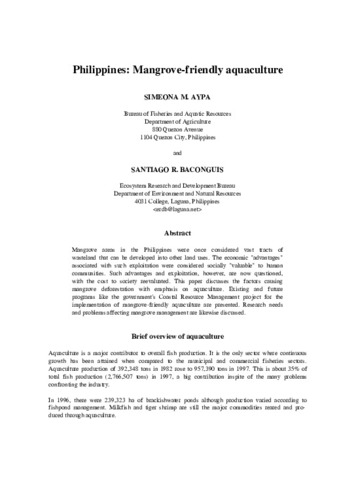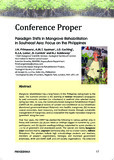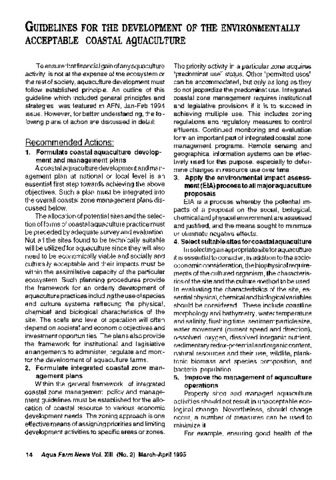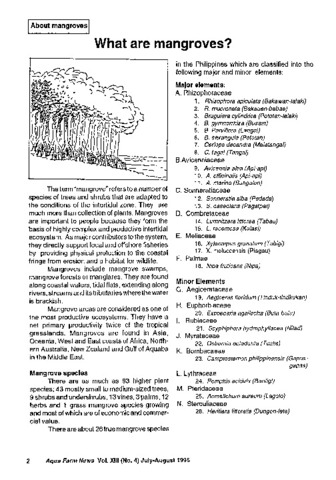Philippines: Mangrove-friendly aquaculture

ရှာဖွေ/ဖွင့်ပါ။
ရက်စွဲ
2000Page views
834
Share
စိတ္တဇ
Mangrove areas in the Philippines were once considered vast tracts of wasteland that can be developed into other land uses. The economic "advantages" associated with such exploitation were considered socially "valuable" to human communities. Such advantages and exploitation, however, are now questioned, with the cost to society reevaluated. This paper discusses the factors causing mangrove deforestation with emphasis on aquaculture. Existing and future programs like the government's Coastal Resource Management project for the implementation of mangrove-friendly aquaculture are presented. Research needs and problems affecting mangrove management are likewise discussed.
Suggested Citation
Aypa, S. M. & Baconguis, S. R. (2000). Philippines: mangrove-friendly aquaculture. In J. H. Primavera, L. M. B. Garcia, M. T. Castaños, & M. B. Surtida (Eds.), Mangrove-Friendly Aquaculture : Proceedings of the Workshop on Mangrove-Friendly Aquaculture organized by the SEAFDEC Aquaculture Department, January 11-15, 1999, Iloilo City, Philippines (pp. 41–56). Tigbauan, Iloilo, Philippines: Southeast Asian Fisheries Development Center, Aquaculture Department.
ဘာသာရပ်
စုစည်းမှုများ စုစည်းမှုများ
Related items
Showing items related by title, author, creator and subject.
-
Paradigm shifts in mangrove rehabilitation in Southeast Asia: Focus on the Philippines
Primavera, Jurgenne H.; Guzman, Armi May T.; Coching, Jofel D.; Loma, Rona Joy A.; Curnick, David; Koldewey, Heather J. (Department of Environment and Natural Resources - Ecosystems Research and Development Bureau (DENR-ERDB), 2014)Mangrove rehabilitation has a long history in the Philippines dating back to the 1930s. The standard practice is the planting of bakhaw Rhizophora propagules by paid community members (or volunteers) in seafront sites ... -
Guidelines for the development of environmentally acceptable coastal aquaculture
Southeast Asian Fisheries Development Center, Aquaculture Department (Aquaculture Department, Southeast Asian Fisheries Development Center, 1995)The paper presents some recommendations for the development of the environmentally acceptable coastal aquaculture such as: 1) Formulate coastal aquaculture development and management plans, 2) Formulate integrated coastal ... -
What are mangroves?
Southeast Asian Fisheries Development Center, Aquaculture Department (Aquaculture Department, Southeast Asian Fisheries Development Center, 1995)The article presents about mangroves and its value to the ecosystem. The different species in the Philippines and mangroves coping mechanisms to the environment are also presented.




